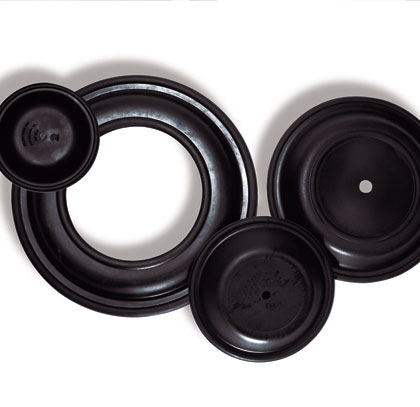Selection of the right diaphragm for an air-operated double-diaphragm (AODD) pump is a critical consideration for safety, efficiency and trouble-free operations. A number of factors must be taken into account when choosing the proper diaphragm that will be suitable for a specific application. Previous experience is always a very helpful guide, but new applications will often require research and outside advice to determine the appropriate diaphragm that will meet specific application requirements and parameters.
In selecting a diaphragm, there are seven primary factors to consider:
- Chemical resistance: Material compatibility with the fluid being pumped. The spectrum of fluids pumped can range from water to aggressive acids and caustics. Each diaphragm material has been tested to measure its compatibility against many chemicals. The operator should evaluate the pumped fluid against published chemical compatibility guides.
- Temperature ranges: Capability to remain flexible in low temperatures and not deteriorate in high temperatures. Temperature is a very critical factor, and the working range available in diaphragm materials varies greatly. The type of fluid can also affect the working temperature range of the material.
- Abrasion resistance: Ability to withstand wear and friction from contact with solids and particles in the fluid being pumped. Diaphragms are available to handle fluids ranging from clear to heavy slurries to dry bulk pumping.
- Sanitary standards: Requirements that the diaphragm comply with hygienic or sanitary standards. Applications in the food and beverage industry must utilize diaphragms that comply with U.S. Food and Drug Administration (FDA) 21 CFR 177 standards. Diaphragms used in the pharmaceutical industry must comply with United States Pharmacopeia Convention (USP) Class VI standards.
- Inlet condition (flooded suction and suction lift): Capacity to pump fluid from one location to another. For different pumping configurations and conditions, certain diaphragm materials are more efficient and longer lasting than others. Outside advice from an expert such as a Wilden distributor can assist in determining the optimum material for specific applications.
- Flex life: Expected longevity of the diaphragm before requiring replacement. Achieving maximum mean time between repairs (MTBR) is a key goal in selecting a diaphragm. However, some materials have inherently shorter flex lives than others even under ideal conditions.
- Cost: Total cost of ownership determined by multiple factors such as initial price, rated flex life for the application and costs of downtime and diaphragm replacement labor. Because of the many variables involved, advice from an outside expert such as a Wilden distributor can greatly assist in selecting the best performing, most cost-effective option for individual applications.
Over the years, a number of materials have been tested extensively for use in diaphragms in AODD pumps. These materials can be grouped into three primary families: rubber, TPE (thermoplastic elastomer) and PTFE (Polytetrafluoroethylene or Teflon®). We’ll begin with a closer look at rubber diaphragms and examine TPE and PTFE in more detail in next month’s installment. Each family and the materials within each family offer properties and attributes that make them suitable for different applications.
RUBBER DIAPHRAGMS
Rubber diaphragms are compression molded of synthetic rubber with a nylon fabric mesh positioned within the rubber to improve the diaphragm’s flexing characteristics. The following are the rubber diaphragm materials available:
- Neoprene is an exceptional general-purpose, low-cost diaphragm. Perfect for nonaggressive chemical applications such as water-based slurries, well water or seawater, it provides good flex life and abrasion resistance.
- Buna-N provides excellent performance in applications involving petroleum/oil-based fluids such as leaded gasoline, fuel oils, kerosene, turpentine and motor oils. In wide use throughout the fuel processing industry, Buna-N is also referred to as nitrile and provides moderate flex life and moderate abrasion resistance. For food and beverage applications, versions are available that comply with FDA 21 CFR 177 standards.
- EPDM is an excellent material for extremely cold temperatures and is an economical alternative when pumping dilute acids or caustics. EPDM diaphragms are in use in the manufacturing, food, pharmaceutical and paint/ coating industries. The material exhibits good flex life and moderate abrasion resistance, and it is available in versions that comply with FDA 21 CFR 177 standards. EPDM is also a good choice where statically dissipative materials are required.
- Viton® is excellent for extremely hot temperatures and provides exceptional performance with aggressive fluids such as aromatic/chlorinated hydrocarbons and strong, aggressive acids. Viton is often the only diaphragm material suitable for applications where harsh chemicals are used because of its high temperature limit and chemical resiliency. It provides moderate flex life and moderate abrasion resistance.
NOTES
Hytrel®, Viton® and Teflon® are registered trademarks of DuPont™ Company.
Geolast® and Santoprene® are registered trademarks of ExxonMobil.
Saniflex™ and Wil-Flex™ are registered trademarks of Wilden®.
About the Author
Rob Jack is a development engineer IV for Wilden® and Pump Solutions Group (PSG®). Wilden is a leading manufacturer of air-operated double-diaphragm (AODD) pumps. He can be reached at 909.422.1784 or rob.jack@psgdover.com. For more information, visit www.wildenpump.com. Wilden is an operating company within Dover Corporation’s Pump Solutions Group (PSG®), which is comprised of several leading pump companies, including Abaque®, Almatec®, Blackmer®, Ebsray®, Finder, Griswold™, Maag, Mouvex®, Neptune™, Quattroflow™, and Wilden®. Find more information at www.psgdover.com.
MODERN PUMPING TODAY, August 2014
Did you enjoy this article?
Subscribe to the FREE Digital Edition of Modern Pumping Today Magazine!



